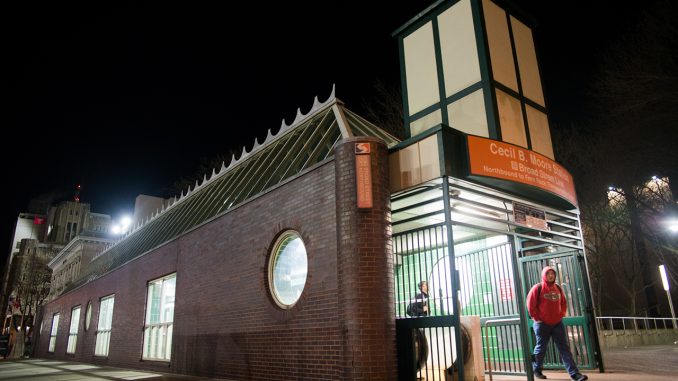
By the end of the month, SEPTA will install two historical displays at Cecil B. Moore station that present facts about the activist’s life.
The Cecil B. Moore Philadelphia Freedom Fighters, the local civil rights activist group that has fought for racial equality since the 1960s, gathered biographical information and images for a digital panel on the southbound side of the station and for historical plaques in the station’s northbound entrance.
“Our goal is to keep [Moore’s] memory alive,” said Karen Asper Jordan, who leads the Freedom Fighters.
Moore was a prominent civil rights figure and walked with the Rev. Martin Luther King, Jr. during the civil rights movement.
The group has been advocating for the panels since August 2013, and it will be complete by the end of the month, said Francis Kelly, SEPTA’s assistant general manager for public and government affairs. SEPTA is organizing an event in the spring to commemorate the installation.
Kelly said the panels would be complete by the end of 2018, The Temple News reported in October 2018. SEPTA will pay more than $1,000 for the project’s fabrication, Kelly said.
“This is money well invested,” he added.
Some members of the Freedom Fighters are the same people who stood alongside Moore, a 1953 law alumnus, in his campaign for equality during the civil rights movement.
Moore is most recognized for his fight to desegregate Girard College, now a first through 12 boarding school on South College Avenue near Corinthian, in the mid-1960s. For more than three years, Moore organized protests to advocate for African-American students to attend the school. In 1968, the school was desegregated.
“We followed Cecil because we believed in him,” Asper Jordan said.
Information and images that reflect Moore’s life, which will be displayed in the panels. SEPTA handled the construction of the panels.
“The kids in the area can learn about a man who did great things for Philly and show them how he made a difference,” said Bernadette Raffner, who lives on 4th Street near Jefferson.
“It is important to understand the civil rights movement, and he was such a big part of it,” she added. “He was not afraid to fight for equality and inclusion.”
Cecil B. Moore Avenue and the Broad Street Line station were renamed in Moore’s honor in 1987 and 1995, respectively.
The group plans to continue working with SEPTA to regularly update the information on the southbound station entrance’s digital panels, Kelly said, which will allow more people to learn about Moore.
On the average weekday, about 7,000 people come through Cecil B. Moore station, a SEPTA spokesperson said.
“Not a lot of people know who he is, so with the number of people who walk around this area, it should bring a lot of awareness to his life,” said Ethan Bailey, who lives on Oxford Street near 24th and uses the station to commute each day.



Be the first to comment